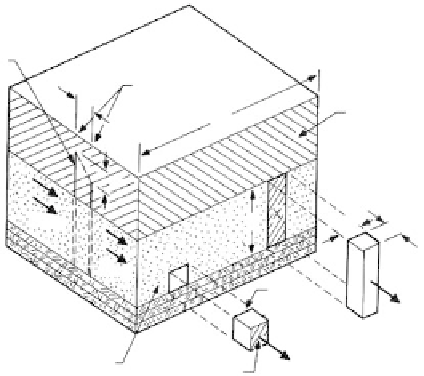Environmental Engineering Reference
In-Depth Information
Hydraulic
gradient
i
=
h
/
L
L
′
Piezometers
Aquiclude
e.g.,
impervious
clay
B
b
A
h
x
Flow
1 ft
D
1 ft
FIGURE 8.23
Coefficient of permeability and
transmissibility as used by hydrogeologists.
(After Krynine, D.P. and Tudd, W.R.,
Principles of Engineering Geology and
Geotechnics,
1957. Adapted with permission
of McGraw-Hill Book Company.)
x
Flow
B
T
Cube
(1 ft x 1 ft x 1 ft)
removed
Aquifer
e.g., sand
K
A
Specific yield
has been defined (see
Section 8.3.1
)
as the amount of water that can be
obtained from an aquifer, or the ratio of water that drains freely from the formation to the
total volume of water. A comparison of specific yield, porosity, and permeability for vari-
ous materials is given in
Table 8.1.
Determination of
k
values is discussed in
Section 3.3
as follows:
Estimation from charts and tables — see
Section 3.3.2
●
Laboratory tests — see
Section 3.3.3
●
In situ
tests — see
Section 3.3.4
●
Stratification
affects permeability significantly. Strata of granular soils are rarely
homogeneous throughout and layering is more often the rule. Water will flow
much more freely horizontally in a clean sand or gravel bed than through silty
or clayey soils, a fact which causes horizontal permeabilities to be often greater
than vertical permeabilities by factors of 10 or 100 or more. An evaluation of the
effect of stratification is given in
Figure 8.24.
●
Rock-mass
permeability was referred to by Terzaghi as “
secondary permeability
.”
In most practical situations, rock-mass permeability is primarily a function
of joint conditions including spacing, aperture width, and the nature of the
filling or of cavity size and distribution. Because of the great irregularity of
these features, including their normally discontinuous nature in most rock
masses, an estimation of rock-mass permeability can be subject to substantial
error. Where rock is essentially intact, values are extremely low for most rock
types, except for porous rocks, such as some sandstones (argillaceous or
highly cemented sandstones may have low permeabilities). Some typical val-
ues are given in
Table 3.12.
●
Pore-Water Pressures
General
Pore-water pressure u
or
u
w
is the pressure existing in the water in the pores, or void spaces,
of a saturated soil element.
Cleft-water pressure
refers to the pressures existing on the water in saturated joints or
other fractures in rock masses.
Excess hydrostatic pressure
is that pressure capable of causing the flow of water.



